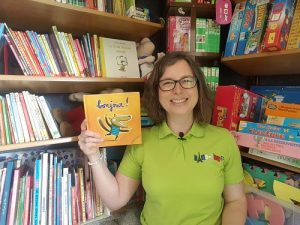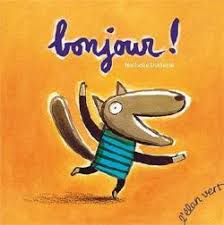

After I saw this book in Clare Seccombe’s blog (Changing Phase) a while back then again when she mentioned it in LiPS (Languages in Primary Schools Facebook group), I finally bought this very cute little book last year. I should have got it earlier! This is to say thank you, Clare!
This story is ideal for a first French lesson, but can be revisited and used all through primary school, so it is a worthwhile investment!
Click here to watch a short video of me introducing this lovely book.
Type of text: picture book
Author or source: Nathalie Dieterlé, published by l’élan vert
Intended age of students: Key Stage 1/2
Source reference: 9782844553218
This is the story of Petit Loup who is very happy and decides to say “bonjour” to everything he comes across. There is a twist at the end of course, which I will need to reveal a little further down…
This story can be used with very young children, to teach them the greeting “bonjour” and practise saying it. Once we have looked at the title and what it means (also said it), and explained the 2 parts of the word “bonjour” (bon-jour) and what they mean (good-day), we agree an action which the children will do when they hear the word “bonjour” in the story; during the second reading, I can do the action and the children say the word “bonjour”. I can then give to the children a copy of the writing from the story (with or without the pictures, which is ok as long as you own the book) and set them off to be language detectives and highlight “bonjour” every time they find it in the story. They may also look for the graphemes “on” and “ou” in other words.
Older children will be able to join in and say bonjour from the first reading; they will also be able to repeat the words for the things Petit Loup is greeting each time. After work on the verbs (see below in the grammar section), we can agree on an action for each verb then the children have to say the missing verbs when I tell the story.
Rationale:
I love this book because it is very versatile and children of all ages will enjoy it, as you can exploit it at different levels, as explained above and below.
It can be used at a basic level to introduce a common greeting in French, but it can also be used to introduce or reinforce certain grammar points.
Outcomes:
At the end, Petit Loup goes to bed, tired… but when his mum says “bonne nuit”, it sets him off again!
Younger children, when they get to the end of the story, can go back through the book and repeat after me as I say this time “bonne nuit” to all the animals and things. I can use this story to practise any greeting of my choice too.
The children can create mini-books of a simplified version of this story where the character only greets various animals and things. Depending on the group, they can rewrite a class version, using different (agreed) greetings and/or different things which are being greeted; they may also create their own versions in small groups or even as individuals, using dictionaries if they are older (from about the age of 7).
Children who have learnt about adjectival agreement in French will also be able to add adjectives to their objects, as in “petites fourmis”.
Topics or themes:
greetings; introduction to French phonics with the sounds “on” and “ou” adjectival agreement
Grammar:
singular and plural of nouns; the 3rd person in the present tense
To exploit this book and the grammar in it, you can use this presentation which I have put together: bonjour exploitation
How much time required:
1-2 lessons
Click here to buy this story on Amazon.co.uk.
What is YOUR favourite story to introduce greetings in French? Please tell me in the comments below!
N.B. Would you like to read about books, ideas, resources and opportunities for the primary languages classroom? Then click here to receive a monthly round up of my blog (and more!) straight in your mail box!

